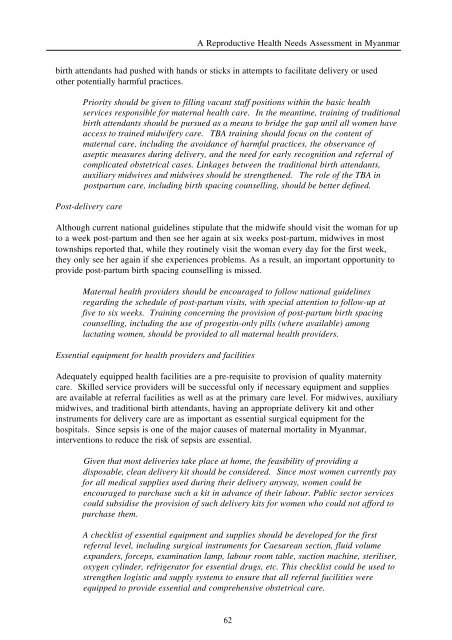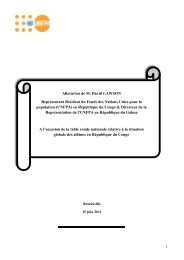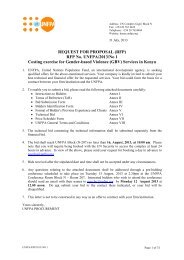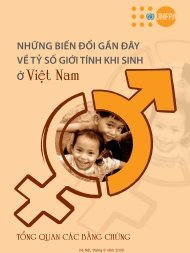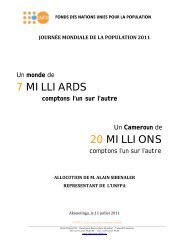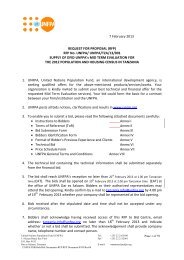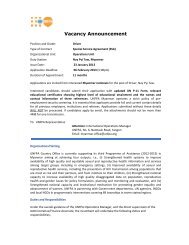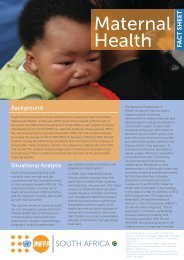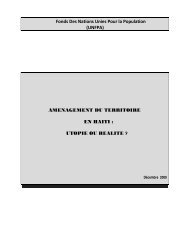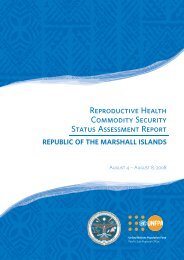A reproductive health needs assessment in Myanmar
A reproductive health needs assessment in Myanmar
A reproductive health needs assessment in Myanmar
You also want an ePaper? Increase the reach of your titles
YUMPU automatically turns print PDFs into web optimized ePapers that Google loves.
A Reproductive Health Needs Assessment <strong>in</strong> <strong>Myanmar</strong><br />
birth attendants had pushed with hands or sticks <strong>in</strong> attempts to facilitate delivery or used<br />
other potentially harmful practices.<br />
Priority should be given to fill<strong>in</strong>g vacant staff positions with<strong>in</strong> the basic <strong>health</strong><br />
services responsible for maternal <strong>health</strong> care. In the meantime, tra<strong>in</strong><strong>in</strong>g of traditional<br />
birth attendants should be pursued as a means to bridge the gap until all women have<br />
access to tra<strong>in</strong>ed midwifery care. TBA tra<strong>in</strong><strong>in</strong>g should focus on the content of<br />
maternal care, <strong>in</strong>clud<strong>in</strong>g the avoidance of harmful practices, the observance of<br />
aseptic measures dur<strong>in</strong>g delivery, and the need for early recognition and referral of<br />
complicated obstetrical cases. L<strong>in</strong>kages between the traditional birth attendants,<br />
auxiliary midwives and midwives should be strengthened. The role of the TBA <strong>in</strong><br />
postpartum care, <strong>in</strong>clud<strong>in</strong>g birth spac<strong>in</strong>g counsell<strong>in</strong>g, should be better def<strong>in</strong>ed.<br />
Post-delivery care<br />
Although current national guidel<strong>in</strong>es stipulate that the midwife should visit the woman for up<br />
to a week post-partum and then see her aga<strong>in</strong> at six weeks post-partum, midwives <strong>in</strong> most<br />
townships reported that, while they rout<strong>in</strong>ely visit the woman every day for the first week,<br />
they only see her aga<strong>in</strong> if she experiences problems. As a result, an important opportunity to<br />
provide post-partum birth spac<strong>in</strong>g counsell<strong>in</strong>g is missed.<br />
Maternal <strong>health</strong> providers should be encouraged to follow national guidel<strong>in</strong>es<br />
regard<strong>in</strong>g the schedule of post-partum visits, with special attention to follow-up at<br />
five to six weeks. Tra<strong>in</strong><strong>in</strong>g concern<strong>in</strong>g the provision of post-partum birth spac<strong>in</strong>g<br />
counsell<strong>in</strong>g, <strong>in</strong>clud<strong>in</strong>g the use of progest<strong>in</strong>-only pills (where available) among<br />
lactat<strong>in</strong>g women, should be provided to all maternal <strong>health</strong> providers.<br />
Essential equipment for <strong>health</strong> providers and facilities<br />
Adequately equipped <strong>health</strong> facilities are a pre-requisite to provision of quality maternity<br />
care. Skilled service providers will be successful only if necessary equipment and supplies<br />
are available at referral facilities as well as at the primary care level. For midwives, auxiliary<br />
midwives, and traditional birth attendants, hav<strong>in</strong>g an appropriate delivery kit and other<br />
<strong>in</strong>struments for delivery care are as important as essential surgical equipment for the<br />
hospitals. S<strong>in</strong>ce sepsis is one of the major causes of maternal mortality <strong>in</strong> <strong>Myanmar</strong>,<br />
<strong>in</strong>terventions to reduce the risk of sepsis are essential.<br />
Given that most deliveries take place at home, the feasibility of provid<strong>in</strong>g a<br />
disposable, clean delivery kit should be considered. S<strong>in</strong>ce most women currently pay<br />
for all medical supplies used dur<strong>in</strong>g their delivery anyway, women could be<br />
encouraged to purchase such a kit <strong>in</strong> advance of their labour. Public sector services<br />
could subsidise the provision of such delivery kits for women who could not afford to<br />
purchase them.<br />
A checklist of essential equipment and supplies should be developed for the first<br />
referral level, <strong>in</strong>clud<strong>in</strong>g surgical <strong>in</strong>struments for Caesarean section, fluid volume<br />
expanders, forceps, exam<strong>in</strong>ation lamp, labour room table, suction mach<strong>in</strong>e, steriliser,<br />
oxygen cyl<strong>in</strong>der, refrigerator for essential drugs, etc. This checklist could be used to<br />
strengthen logistic and supply systems to ensure that all referral facilities were<br />
equipped to provide essential and comprehensive obstetrical care.<br />
62


